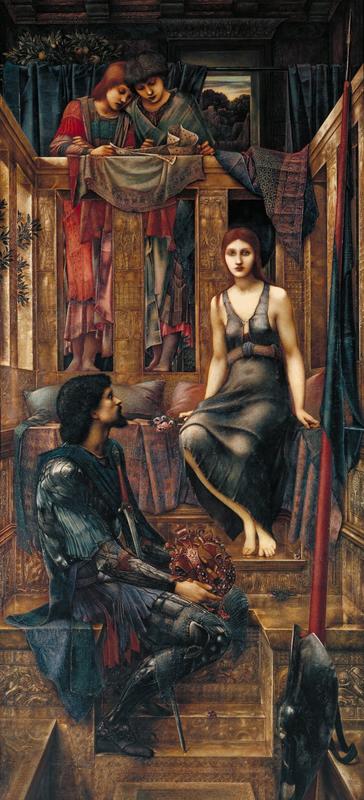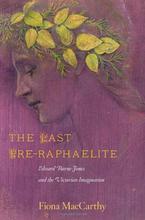More about King Cophetua and the Beggar Maid
- All
- Info
- Shop

Contributor
King Cophetua and the Beggar packs quite the visual punch. But it's debatable whether the legend behind its jewel-toned brushstrokes is one of true love or naive attraction.
Before Harry Potter left Privet Drive, Eliza Doolittle learned phonetics, and Rocky Balboa threw his first punch, Penelophon was the cover girl of the rags-to-riches tale. According to legend, this “beggar-maid” received the unlikely attention of an African monarch. King Cophetua, who had always been mysteriously devoid of a sex drive, first glimpsed the young maiden while gazing through a window. Immediately stricken (and apparently filled with newfound lust), the king saw only two options: he would marry the comely stranger or take his own life. Thankfully, Penelophon was flattered by her suitor’s hasty affections. She agreed, quickly ascending to the throne and shedding her previous life of poverty.
Burne-Jones was sure to emphasize the class difference between the two lovers—note Penelophon’s grey smock and bare feet, a clear contrast to Cophetua’s ornate crown. He did, however, idealize his subjects: he ensured Penelophon’s rags were not too “unappetizing” to draw royal affections. Many interpret Burne-Jones’ Penelophon as a doppelganger of his wife Georgina. Their relationship was a rocky one, with theatrics to equal those of Frida Kahlo and Diego Rivera. The tension culminated in Burne-Jones’ extramarital relationship with model Maria Zambuco. When they broke up, a distressed Zambuco publicly threatened to drown herself.
Cophetua and Penelophon’s love story inspired Agatha Christie’s term “Cophetua Syndrome” and Graham Greene’s “Cophetua complex,” referring to a man’s attraction to a woman of lower social stature. The tale is also referenced in numerous Shakespeare plays, including "Romeo and Juliet." Perhaps the most concerning nod to the beggar maid was Lewis Carroll’s photo of the same title, depicting the child Alice Liddell as Penelophon. The photo appears in The Met and continues to discomfit modern audiences, who question Carroll’s suggestive photos of his young models.
Sources
- “Alice Liddell as ‘The Beggar Maid.’” Met Museum. Accessed September 30, 2018. 2018. https://www.metmuseum.org/art/collection/search/283092.
- Easby, Rebecca Jeffrey. “Burne-Jones, King Cophetua and the Beggar Maid.” Khan Academy. Accessed September 30, 2018. https://www.khanacademy.org/humanities/becoming-modern/victorian-art-ar…
- “The King and the Beggar-maid.” Wikipedia. April 30, 2018. Accessed September 30, 2018. https://en.wikipedia.org/wiki/The_King_and_the_Beggar-maid.
- Muñoz-Alonso, Lorena. “Was Lewis Carroll a Pedophile? His Photographs Suggest So.” Artnet News. January 30, 2015. Accessed September 30, 2018. https://news.artnet.com/art-world/was-lewis-carroll-a-pedophile-his-pho….
- “Study of the Maid for ‘King Cophetua and the Beggar Maid.’” Tate. Accessed September 30, 2018. https://www.tate.org.uk/art/artworks/burne-jones-study-of-the-maid-for-….
Featured Content
Here is what Wikipedia says about King Cophetua and the Beggar Maid (painting)
King Cophetua and the Beggar Maid is an 1884 painting by the Pre-Raphaelite artist Edward Burne-Jones. The painting illustrates the story of 'The King and the Beggar-maid", which tells the legend of the prince Cophetua who fell in love at first sight with the beggar Penelophon. The tale was familiar to Burne-Jones through an Elizabethan ballad published in Bishop Thomas Percy's 1765 Reliques of Ancient English Poetry and the sixteen-line poem The Beggar Maid by Alfred, Lord Tennyson.
Burne-Jones first attempted the story in an oil painting of 1861–62 (now in the Tate Gallery, London). He was working out a new composition around 1874 or 1875, and began the painting in earnest in 1881. He worked on it through the winter of 1883–84, declaring it finished in April 1884.
The composition is influenced by Andrea Mantegna's Madonna della Vittoria (1496–96). Several studies for the final work survive. A small gouache (bodycolour) of c. 1883 (now in the collection of Andrew Lloyd Webber) shows the king and the beggar maid much closer together, and a full-scale cartoon in bodycolour and coloured chalks of the same year (now in the Birmingham Museum and Art Gallery) features an entirely different approach to lighting the figures.
King Cophetua was exhibited at the Grosvenor Gallery in 1884 and became Burne-Jones's greatest success of the 1880s for its technical execution and its themes of power and wealth overborne by beauty and simplicity. It was heralded as the "picture of the year" by The Art Journal and "not only the finest work Mr. Burne-Jones has ever painted, but one of the finest pictures ever painted by an Englishman" by The Times. The painting was exhibited in France in 1889, where its popularity earned Burne-Jones the Legion of Honour and began a vogue for his work. The artist's wife Georgiana Burne-Jones felt "this picture contained more of Edward's own qualities than any other he did."
The painting was purchased by the Earl of Wharncliffe (d. 1899) and acquired by public subscription through the Burne-Jones Memorial Fund from his executors in 1900. It is now in Tate Britain. The full-scale cartoon was acquired for Birmingham in 1947.
The painting is referenced in Chapter 4 of Anthony Powell's "Books do Furnish a Room", the tenth installment of "A Dance to the Music of Time", as a visual set-up for the confrontation between X Trapnel and Kenneth Widmerpool in the former's digs in bombed out Little Venice circa 1947. Pamela Widmerpool is envisioned as the Beggar Maid.
The painting is also mentioned in the story "The Beggar Maid" by Alice Munro, where Patrick compares Rose to Beggar Maid, and Rose then looks at the picture only to find out how un-like King Cophetua Patrick would ever be, and how impossible their marriage would be (which turns to be the case). It also merits a mention in A.N. Wilson's novel "Kindly Light."
Check out the full Wikipedia article about King Cophetua and the Beggar Maid (painting)













